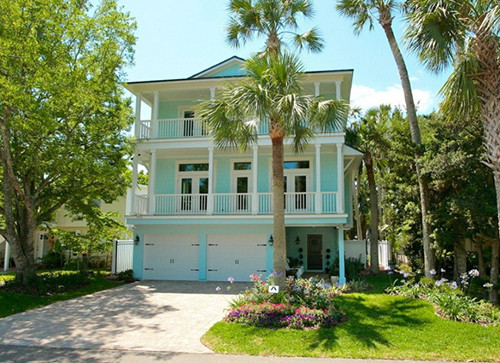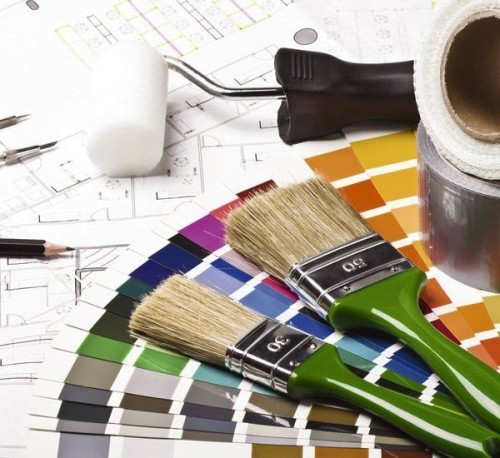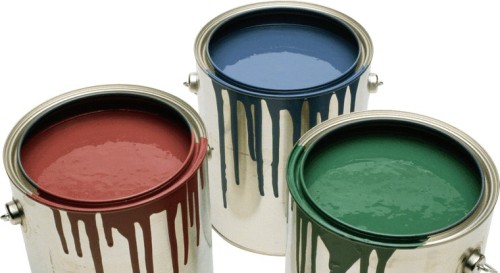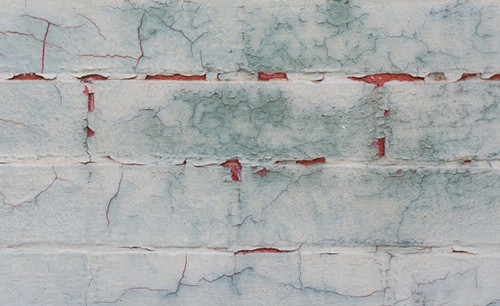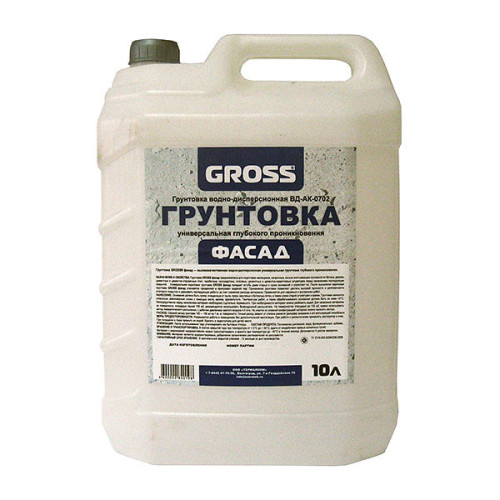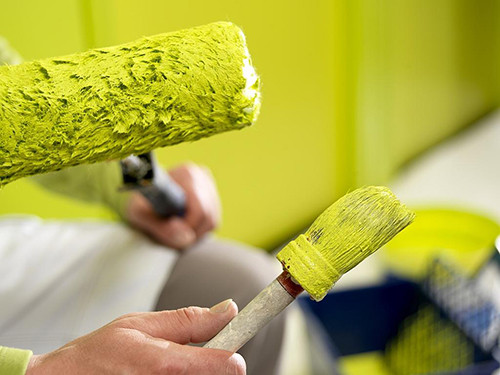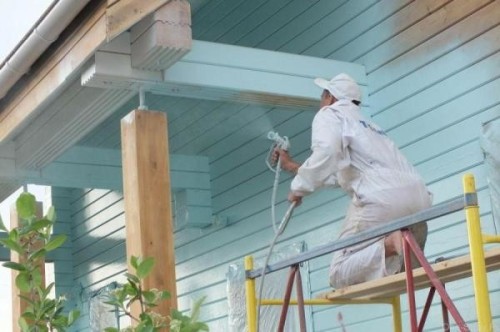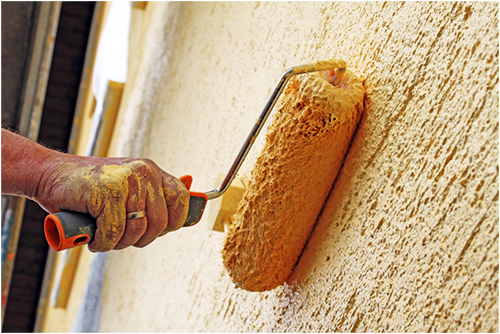
Painting plaster for facade paints and varnishes,Walls

Exterior decoration is an important component of construction, and each owner wants to get a beautiful and tidy house, but at the same time save money on finishing materials. The color of the facade by plaster is the cheapest and easiest way to improve the exterior of the building. Even a person inexperienced by painting a man will cope with such work, and in today's article you will learn how to choose the facade paint and apply it on the walls.
Content
Selecting paint
Not any paint is suitable for staining of the facades. Before determined with the color and value of the material, it is necessary to understand that there is a building paint for internal and external works. In our case, the compositions are needed for external work, since any others are not able to withstand specific operating conditions: temperature and humidity differences, exposure to ultraviolet, etc. The usual paint simply flies after the first rain or cracks up with the onset of frosts, and work will have to begin again.
So, we need paint for outdoor work, but there are nuances here. For example, various formulations may differ in the temperature resistance range. So, if you live in the south, where summer is very dry and roast, it is better to choose paint, able to withstand high temperatures and not burn into direct sunlight. If we are talking about a house in the northern region, you need a frost-resistant paint.
You should also make a choice based on the walls of the walls. For example, for painting the facade of the house of the foam blocks without plaster it will take good moisture-resistant paint, capable of masking irregularities and minor cracks on the surface. For concrete walls, another paint is needed. Usually professional builders follow one simple rule - what plaster, such and paint. This means that if the plaster is based on silicone, then the paint needs silicone to her, and if used acrylic plaster for the facade, then the paint must be taken acrylic. Otherwise, materials other than their nature can conflict, leading to premature destruction of the building.
For a better understanding of the specifics of the choice of colors for the facade by plaster, we suggest considering the properties of various compositions:
- Silicate - paint based on liquid glass with the addition of mineral and silicone fillers. It has high resistant to direct sunlight, rain, snow, any kind of precipitation. The service life is 15-25 years, depending on the manufacturer and operational conditions. Despite its hydrophobicity, the silicate paint is vapor permeable, which allows the walls to "breathe" and freely evaporate moisture. The only serious lack of these compositions is cracking at high temperatures due to its inelasticity, therefore, silicate paints do not use silicate paints for the color of the facades in extremely hot conditions.
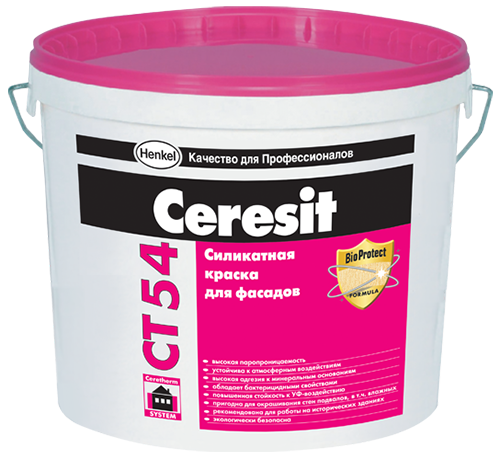
- Cement - paints based on harated lime and portland cement. Characterized by vapor permeability and minor bactericidal impact, but in private construction, these compositions are almost not used due to their briefness and impracticality.
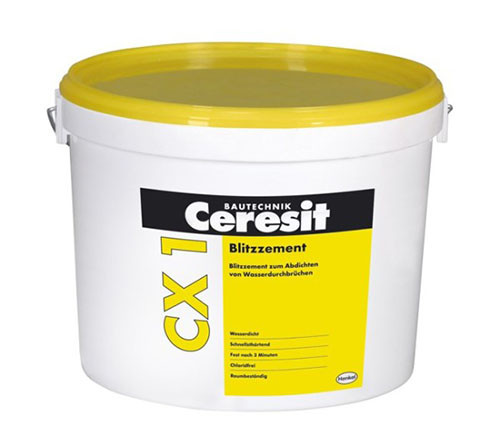
- Acrylic - water-soluble acrylic paints. Especially popular due to low cost and good quality. The compositions are non-toxic, do not distinguish the smell, the service life is 8-12 years, depending on the operational conditions. Require minor surface preparation before applying. Convenient to the fact that it is easy to calm, it means that if you bother the color of the facade, you can apply a new paint on top of the old surface without preliminary surface stripping. A very wide color palette allows you to paint the facade plaster in any shade.
- Silicone - paints, distinguished by a high level of moisture resistance, and at the same time preserving vapor permeability due to the presence of microscopic pores. Possess excellent adhesion with any kind of plasters, do not fade in direct sunlight, presented in a wide color palette. Paints are well tolerated by a hot summer and frosty winter. There are special anti-corrosion silicone compounds for painting outdoor metal communications on the facade. An interesting feature - paint is not electrified and does not attract dust, and therefore the facade remains clean longer. The disadvantages of silicone compounds include low elasticity compared to acrylic paints, as well as fairly high cost.
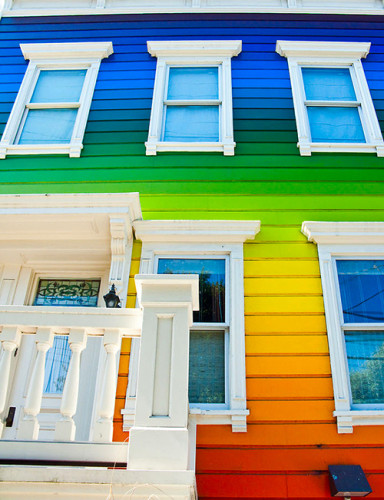
Most often, builders choose the facade paint along the stucco on an acrylic basis, since it is inexpensive, wear-resistant and easy to use.
Calculation of the amount of paint
So, if you have decided on the type of paint on the plaster, it's time to calculate how much it will be needed for the entire facade. To do this, pay attention to the packaging of the selected paint - there is always a consumption in liters per square meter of the surface into one layer. In some cases, it can be written on the contrary - how many square meters of the surface can be covered with a liter of this paint.
Often manufacturers write the consumption of composition at a certain interval like 0.1-0.25 l / m². A smaller difference digit here means painting smooth surfaces, but a large - rough or not covered with primer walls.
To save your time, you can go to the manufacturer's website of the manufacturer of selected paint and search there online Calculator to calculate the number of cans depending on the facade area. Typically, you need to enter data on the type of surface and its quadrature, after which the calculator will automatically calculate the paint volume.
Important: Consider that the facade paint is recommended to apply in two layers, and therefore it will be necessary twice as much as written on the package.
To find out the number of paint yourself, it is necessary to multiply the area of \u200b\u200bthe stainable surface in square meters to the paint consumption, then the resulting number is multiplied by 2, since you need to apply two layers and add a stock coefficient of 1.1. When buying any building materials, you need to take a little more computational number just in case.
It is clear that the painting of wooden facades, brick or concrete walls will take a lot of time, and therefore the paint needs to be stored somewhere. To do this, select the shaded and dry place. Packaging should not be under direct sunlight, they should be protected from frost (the temperature may vary from + 5c to + 27c, see the detailed storage conditions on the package). If you opened a new bank and saw that the paint was smelled, that is, there is a transparent liquid on the surface, and the pigment of the donkey is slightly lower, mix it thoroughly with a stick or construction mixer. This is a completely normal phenomenon and well-mixed paint will fully comply with the declared characteristics.
Application of paint
The durability and quality of the outer decoration directly affects the thoroughness of the preparation of the base before the color. The plaster of the facade under painting should correspond to the figmeal used and vice versa. It will provide better adhesion and wear resistance. Any stucco should be pre-primed. In this case, the primer will serve as additional protection against dampness and compact the base.
If you work with an old wall, check the condition of its plaster layer. Highly cracking plaster should be removed and cleaned. This can be done with a strong water pressure or manually with a rigid metal brush and a spatula. If you have noticed the place of cluster of moss or mold, clean them and process them with an antiseptic preparation. If this is not done and just paint the wall of fresh paint, after some time mold or moss will grow again and destroy the finish from the inside. All gaps, holes and chips in the wall should be embedded with putty. The same applies to plastered places.
To determine how strong the wall of the house is, and whether it needs to be strengthened and new plastering, cover a piece of conventional transparent tape to the surface, pretty pressed and sharp movement with a sharp movement. If the walls of the wall remained on the sticky tape, then the base is fragile, and it needs to be strengthened - to consider the old plaster and apply a new one. If the tape remains relatively clean, you can proceed to the primer and painting.
The technology of painting the facade plaster is reduced to the following:
- The still plastered facade should be left for 30-60 days for drying (the period depends on weather conditions, the thickness of the plaster layer and the characteristics of the plaster itself).
- Apply primer. If you work with an inextentive home from silicate brick, its walls can be covered with a colorless protective primer, and then paint. However, regardless of dependence, there is plaster on the facade or not, it is necessary to primitive.
- Coloring facade.
The only material that is better not to paint is a facing ceramic brick. But this is not because the paint will not hold on it - just such a material itself is quite beautiful and self-sufficient. If you work with a new home from the burned brick, plastering and paint the facade is better as quickly as possible so that they do not appear on the surface of the brick wall.
Grinding wall
Many do not understand or underestimate the importance of primer before staining the wall. The primer composition works as follows: it penetrates the walls into several centimeters and freezes there, filling the microcrack and forming a protective film on the surface. Thus, the wall material becomes more densely, stronger and better hits with paint. Since all the cracks and pores of the wall material are filled with primer, the surface becomes smoother and absorbs moisture. The moisture is contained in any paint, and if the base is too porous, it is quickly absorbed, and you will need several times more paint.
The primer significantly reduces the consumption of facade paint due to blockage of pores and cracks in plaster and wall. Its value is much lower than that of the cheapest facade paint. Choose the primer should depend on the paint composition used. Typically, this information is specified on the package. Ideally, you should use primer and paint from one manufacturer.
Useful advice: To improve the quality of painting, use the primer of the same tone as the color of the facade paint. In some cases, instead of primer, the paint itself can be used for external work, diluted with water in proportion of 1: 1.
After priming the surface, leave it to dry out for 1-2 days.
Selecting tools
As you understand, the color of the facade is a very time-consuming event, and a narrow painting tassel is clearly not enough. However, the choice of tools for applying primer and paint depends on the consistency (viscosity) composition, as well as the characteristics of the surface texture and your work skills in this area.
The most common tools - brushes and roller. If you work with enough smooth walls, choose tools with a short pile. The roller in this regard is much more convenient and will allow you to finish work faster with less paint consumption. Brush may be needed for staining of hard-to-reach places, for example, near door openings, for pipes, the windowsill, etc. If you work with textured plaster, use a wide painting brush with long bristle.
A few words about kraskopults. These devices allow you to quickly cover the paint large areas, but at the same time the dye consumption increases significantly. It is convenient to work as collapse in relief surfaces, but it will take a little to practice a little. There is nothing complicated in the work, it is only important to understand how to control the pressure of the air and learn how to handle the tool. It will take an hour of your time and a little paint. It is important to choose correctly choose the viscosity of the paint and the diameter of the sprinkler nozzle - if the paint is too thick, and the nozzle is too small, it will just break.
Coloring technology
When you prepared the paint on the plaster for the facade of the house, primer and tools, you can start work. If you paint the walls of a low home, you will need a stepladder. However, constantly rearrange the stairs is very uncomfortable and tedious, so ideally it is necessary to build forests (make from boards or rent in a specialized company). For houses in 3 floors and above, it is already necessary to equip for high-rise works. This is due to a certain risk, and therefore it makes sense to entrust work to those skilled in the art. Alternatively, you can paint the first two floors on your own, and work at a height to entrust the hired employee.
Painting technology:
- During the day to work, look at the weather forecast - on the day of color and a couple of days after it should be dry and moderately warm weather. If wind is planned, cooling up to + 5c and below,. Rain or fog, exterior decoration is better to postpone.
- Remove from the surface of dust and pollution with a metal brush.
- Apply the primer and let it dry completely.
- All parts of the facade that should not be painted (windows, slopes, scene, etc.) Close with polyethylene or painting tape.
- Apply the first layer of paint on the wall, trying not to make long breaks in work. It is better to work in a few hands so that there is no difference in the shades of painting and divorces.
- Apply the second layer of paint after complete drying of the first. Drying time depends on the composition of the paint and is indicated by the manufacturer on the package.
Useful advice: In order for each time during breaks in the work, you do not wash the brush or paint roller, climb them into a plastic bag - so the paint does not dry.
Painting facades by plaster is not just one of the cheapest and simple ways to get a beautiful and original home. Properly chosen and qualitatively applied paint will provide additional protection against moisture and will extend the life of the walls of the house.




